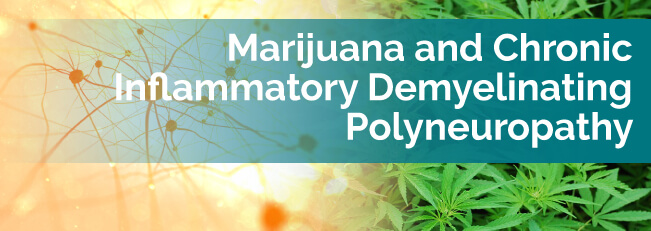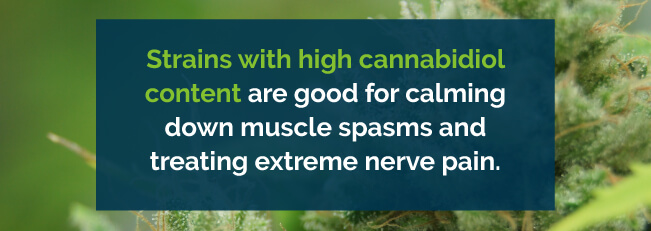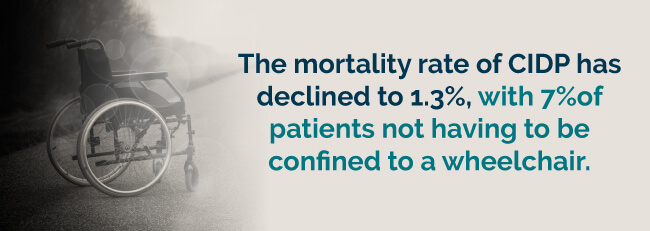
You’re probably aware of the benefits medical cannabis provides. Medical marijuana has characteristics that can alleviate common symptoms — especially pain and muscle spasms — of some conditions, including chronic inflammatory demyelinating polyneuropathy (CIPD).
Using medical marijuana for CIPD has helped patients manage the pain and inflammation associated with this condition, as well as other symptoms. It may even slow down the progression of the disease.
The pain you experience from CIDP is similar to other types of pain, especially pain associated with multiple sclerosis. Medical cannabis for CIDP treatment has been very successful in patients. Pot can help reduce inflammation and pain. It can also help relieve muscle spasms, tingling sensations and other symptoms related to CIDP.
Recent studies of cannabis and CIDP treatment showed that at low doses, weed is useful, and significantly reduces neuropathic pain and improves sleep.
Even raw cannabis has benefits for treating CIDP. This is due to the compound (E)-BCP (beta-caryophyllene) that activates the CB2 receptor, which is what makes it so effective.
Although there isn’t any treatment that can stop the progression of CIDP at the moment, medical cannabis can potentially slow it down due to its anti-inflammatory properties, which have a stabilizing effect on the pathways that influence how severe your immune response is.
CIDP involves your body attacking its healthy cells, and medical cannabis can help repress the strength of those effects. Your CIDP will not progress as fast when there’s a decline in healthy cells being destroyed.
Marijuana for CIPD symptoms is effective in reducing:
Weed helps improve sleep patterns and helps with chronic fatigue and insomnia.
Strains with high cannabidiol content are good for calming down muscle spasms, treating extreme nerve pain and reducing joint stiffness and inflammation. Strains that are high in cannabidiol content are also good for treating convulsions, muscle spasms and nerve pain. You will experience a mild sedative effect, so it’s perfect if you’re struggling with insomnia.

High cannabidiol content strains also have antidepressant properties.
All the strains below are great for treating symptoms of CIDP, including:
Your budtender and medical marijuana doctor can help you select the best strain for you. Some potential strains to consider include:
To shop for a marijuana and CIDP strain and find a prescribing physician, use our search directory to find a medical marijuana dispensary or doctor. MarijuanaDoctors.com can connect you with marijuana doctors in all legal marijuana states and ensure you are in compliance with your state laws. Book your appointment and let us help improve your quality of life!
For more information about how cannabis can be used to treat Chronic Inflammatory Demyelinating Polyneuropathy, check out our resources:
Find A Doctor Find A Dispensary
CIPD is a long name to describe a medical condition that causes a handful of debilitating symptoms like pain, muscle weakness or paralysis, fatigue or loss of sensation in areas of your body. Between 5,000 and 10,000 individuals in the U.S. are affected by this condition at any one time, reports GPS/CIPD Foundation International.

CIPD is a nerve disease, bringing pain, numbness and weakness that can occur at any time during your life. Experts don’t know exactly what causes this disorder. A prevailing theory is that the roots of your nerves swell and destroy the fatty tissue (myelin sheath) around your nerves, leading to CIDP. This can result in impaired limb function and progression of other symptoms.
You may experience a slow symptoms decline over an eight-week period or more, and then have a few months of slow improvement or remissions. You can also relapse anytime over the years and never fully recover. Although CIDP is similar to other diseases, like progressive inflammatory neuropathy or Guillain-Barré syndrome (GBS), the difference is that an infectious or viral doesn’t precede it.
CIDP is believed to be the chronic form of acute inflammatory demyelinating polyneuropathy (AIDP), which in the U.S. and Europe is the most common form of GBS. Guillain-Barré syndrome progresses over a three- to four-week period, before improving after a few months and disappearing. CIDP, on the other hand, usually doesn’t improve unless you are receiving ongoing treatment.
CIPD is a difficult disorder to diagnose. Because it is a rare condition, physicians often have to rule out other diseases before they can arrive at a CIDP diagnosis. Testing for CIDP typically involves undergoing a nerve conduction test, which tells your doctor how fast your nerve impulses make their way through your body. Also, your doctor may order urine tests and a spinal fluid analysis to help to rule out other conditions that may be causing your symptoms.
CIDP often comes on secretly and develops slowly. It may gradually progress, or you can relapse — both with either partial or complete remission between its return. You will experience periods where the disease worsens and then an improvement in your condition that typically lasts for a few weeks to several months. To receive an official diagnosis of CIDP, your symptoms must last over eight weeks.
Reported symptoms of the condition include:
Other symptoms associated with CIDP include:
You may also have difficulty swallowing, slurred speech, changing voice or hoarseness.
Every person’s outcome varies. You may experience repeated episodes of the symptoms, or they may continue long-term. With ongoing treatment, full recovery is possible. However, it’s not uncommon to suffer permanent loss of your nerve function.
Some potential complications and effects of CIDP include:
If you experience any loss of sensation or movement in any area of your body, it’s important to call your doctor, particularly if your symptoms worsen.
Statistics from the journal Neurology reported by the National Institutes of Health show:

CIDP affects up to 3.6 million people each year, with around 40,000 U.S. patients affected at any one time, according to the American Association of Neuromuscular & Electrodiagnostic Medicine.
Current Treatments Available for CIDP and Their Side Effects
Early treatment is essential to prevent nerve damage. It can also decrease the severity of your symptoms and prevent them from getting worse.
CIDP treatment is somewhat of an art. Having an experienced physician and autoimmune disorder specialist working with you is key to a better outcome. If treated early, you’re more likely to respond well to the treatment and limit peripheral nerve damage. Early treatment also helps improve function and quality of life, and can help slow the progression of CIDP. Occasionally, early treatment has been able to cure the condition altogether.
CIDP treatment may include:
Corticosteroid treatments slow your immune system and reduce inflammation.
Corticosteroid treatment comes with many side effects that range from mild to severe. Side effects of corticosteroids are apparent when you take them for extended periods of time or at higher doses.
Corticosteroids can cause:
Using corticosteroids for a prolonged period can lead to obesity, convulsions and even psychiatric disturbances such as mood swings, euphoria, personality changes and depression.
Your physician may inject you with concentrated antibodies from healthy people. These injections slow the immune response of your body.
You may experience mild or moderate side effects, such as:
With this treatment, you’ll receive plasma through an IV to slow down your immune system.
According to a study of 5,235 procedures performed, 12 percent produced side effects in patients treated.
Common side effects experienced were:
Although most side effects have very little or no clinical significance, plasma exchange has led to 28 severe complications among patients, including two respiratory arrests and one cardiac arrest.
Immunotherapy treatment interrupts your immune system to keep it from harming the myelin.
Immunotherapy affects people in different ways. Skin reactions at the needle site are most common, with other side effects including:
You may also experience flu-like symptoms such as:
Other side effects you may experience include heart palpitations, diarrhea, sinus congestion and risk of infection. As with any treatment, immunotherapy can cause severe allergic reactions that could prove fatal, although rare.
Your physician may suggest physical therapy. Your CIDP symptoms can be manageable, where you might only need over-the-counter pain relievers. For pain that is harder to manage, your doctor might prescribe prescription-strength pain relievers.
All pain relievers come with risks — even over-the-counter drugs. However, narcotic pain relievers carry the most risk. With narcotic pain relievers, you may experience:
There’s a broad range of second-line drugs doctors may use to treat CIDP. These, however, usually only come into play if the treatments above fail. These medications are often not tested in randomized controlled trials, and some of them have significant side effects. However, their use is based on medical literature and case series.
Due to that fact that neuropathic pain is often refractory to conventional prescription remedies, sometimes an alternative treatment option such as marijuana is necessary. One compound in medical marijuana, (E)-BCP (beta-caryophyllene), is an anti-inflammatory, but doesn’t affect the molecular receptor that makes you feel stoned.

Instead, this compound could help a condition such as CIDP because it activates only the CB2 receptor, which plays a key role in alleviating inflammation. Inflammation is necessary for wounds and infections to heal. However, chronic inflammation can lead to a host of diseases, such as atherosclerosis, rheumatoid arthritis and even cancer.
If you take medical cannabis as prescribed, it’s usually safe. Mild side effects you might experience include:
You may recover completely from CIDP. However, many individuals end up living with symptoms of nerve damage like weakness or numbness.